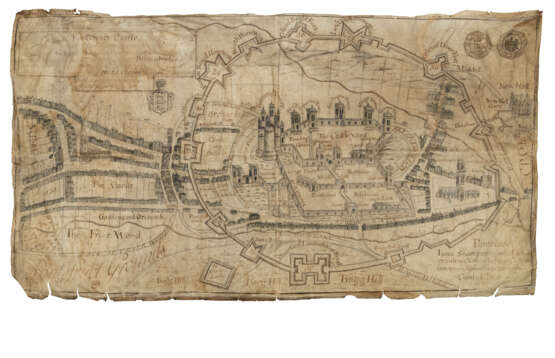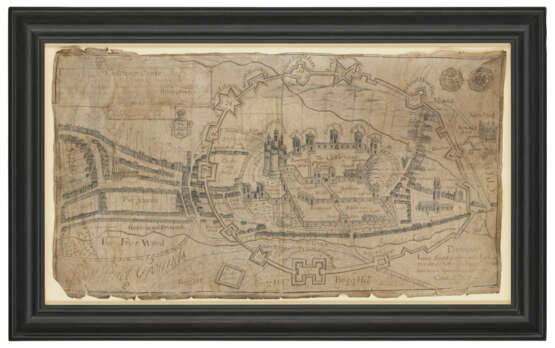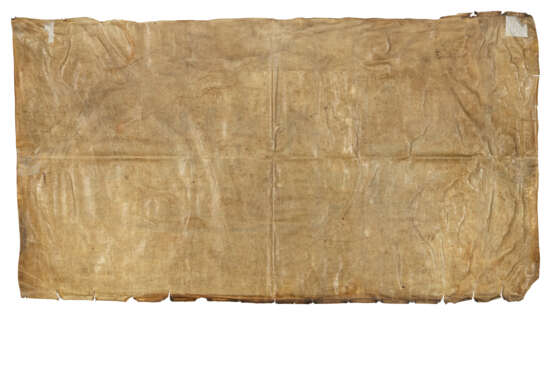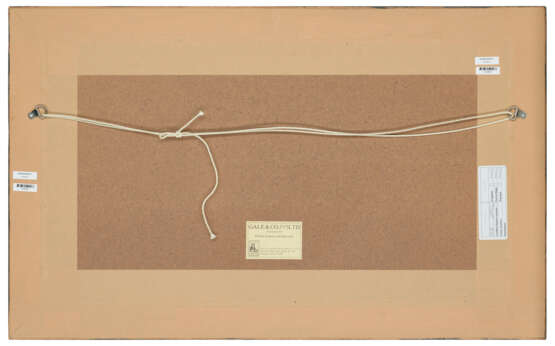ID 993221
Lot 174 | ENGLISH CIVIL WAR
Estimate value
£ 5 000 – 8 000
'The Siege of Pontefract Castle. Anno Dom: 1648.' [First half of the 18th century.]
A fine drawing on vellum depicting Pontefract Castle during the siege of 1648. The castle is depicted in detail with its towers and walls and the ring of forts besieging it all labelled. Outside the castle walls to the west is the town and houses of Pontefract with the church of St Giles and the market cross, together with yards, gardens and orchards, and ‘Frier Wood’. To the east of the castle is the church of All Saints, and the Elizabethan manor house New Hall built in 1591 by Edward Talbot, from a design by Robert Smythson, who was the architect of Hardwick Hall in Derbyshire.
The drawing also incorporates quotations about Pontefract from the works of the antiquaries John Leland, and William Camden in the upper left and lower right corners respectively. In addition both sides of a coin struck during the siege at Pontefract in 1648 is depicted in the upper right corner of the drawing.
This drawing was engraved by James Basire and issued by an unknown publisher in c.1750s (BL cat.) and is titled 'The siege of Pontefract Castle 1648. From a drawing found in the possession of a descendant of the Fairfax family of Denton'. Holmes, referring to the print which is based on this drawing, notes that it 'is incorrect in many details, mistakes being made which could have been possible to no one who knew the ground. For instance, within the walls, the road from Southgate to the Porter’s Lodge is represented as being a straight ascent, with no hint of the great difference of level between the two Barbicans; the names of King’s and Queen’s Towers are transposed; there is no Main Guard, or any building on its site; the Flanker Wall starts from the wrong angle; and even a prominent object like Mr Warde’s house on the opposite side of the graft, from which the besiegers attempted to mine towards the Round Tower, and whence Mr Warde communicated by word of mouth with the besieged is entirely ignored … even the “Deus” on siege coin is represented by “Dius” … It is to be feared that that its pretended origin is very apocryphal' (Holmes, p. 411). References: Holmes, Richard, Collections towards the history of Pontefract. Volume II. The Sieges of Pontefract Castle, 1644-1648 (Pontefract: Richard Holmes, 1887), Supplement, pp. 410-418. Briggs, K.M., The Castilians (1949), [this map published as the endpapers].
Pen and ink and watercolour over pencil on vellum (315 x 595mm). (Slight chipping at edges and other minor holes, vertical and horizontal crease from being folded.) In a modern glazed frame. Provenance: through the Fairfax family to Charles Fairfax Crowder, of Edgbaston (1859-1951) – thence by descent to the present owner.
| Place of origin: | Northern Europe, Europe, United Kingdom |
|---|---|
| Auction house category: | Maps & Atlases |
| Place of origin: | Northern Europe, Europe, United Kingdom |
|---|---|
| Auction house category: | Maps & Atlases |
| Address of auction |
CHRISTIE'S 8 King Street, St. James's SW1Y 6QT London United Kingdom | |
|---|---|---|
| Preview |
| |
| Phone | +44 (0)20 7839 9060 | |
| Buyer Premium | see on Website | |
| Conditions of purchase | Conditions of purchase |






